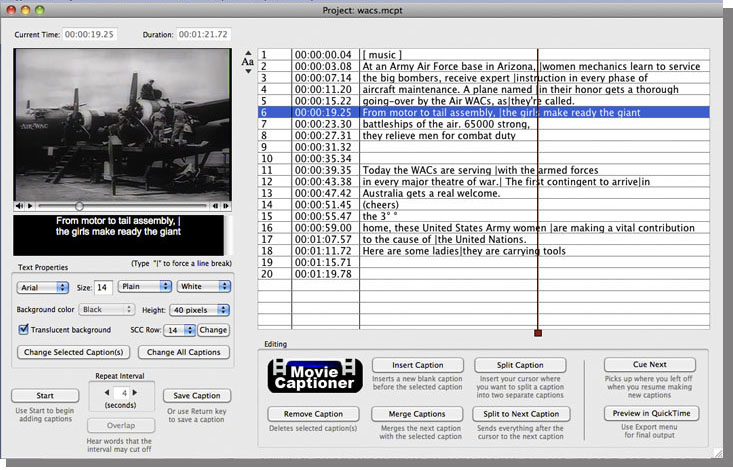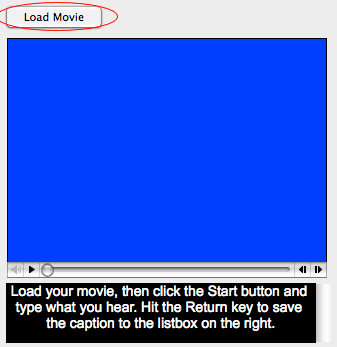MovieCaptioner is quickly becoming the go-to software for captioning. It is being used by many government agencies such as NASA, NOAA, the Department of Homeland Defense, universities such as Penn State, Cal Poly, Ohio State, and Gallaudet, to name a few, and television show producers, such as MOTORZ TV and Southwest Expeditions Docuseries are using MovieCaptioner to create closed captioning.
About MovieCaptioner


- On a Mac you can use Compressor to add your SCC caption file to your video either for broadcast TV, Apple devices, or DVDs. Also, if you have QuickTime Pro, you can take advantage of another export option in MovieCaptioner that's available only on Macs that allows you to embed your SCC captions into an MPEG-4 movie.
- MovieCaptioner for Mac lets you create captions for your movie collection. With it, you can import existing transcripts and the output file can be saved to a variety of extensions, including SRT and Dooble.
MovieCaptioner is a captioning program for Mac OS X and Windows that streamlines the task of captioning video content by looping one short section of a video at a time.
In addition to simplifying the captioning process, MovieCaptioner also has the ability to export captioned videos as QuickTime movies, as well as standalone caption files in a variety of formats.
Getting MovieCaptioner

Plese contact Andrew Normand, Web Accessibility Program Leader, if you would like further information.
Moviecaptioner For Mac
Creating a Caption File - Minimal Path
The fastest way to create captions is by creating a text transcript of the video and then use MovieCaptioner to set the timecodes for each line of text.
Create a Transcript
- Start by opening your video in a video player, such as VLC.
- Click 'Playback' and adjust the Playback Speed to suit your typing speed (0.35 is a good starting point).
- Open a text editor
- Adjust the size of the windows so that you can see both the video player and the text editor.
- In order to keep your captions to one line they should be no longer than 54 characters in length. Add some characters to the text editor as a guide:
123456789012345678901234567890123456789012345678901234 - Play the video and type the transcript. Note: line breaks should reflect the natural flow of the sentence and its punctuation.
- Save the transcript as a TXT file
Create Captions
- Open MovieCaptioner.
- Click 'Load Movie' in the top left corner of the screen.
- Find your video on your hard drive and click 'Open'.
- MovieCaptioner accepts MP4, MOV, M4V, and MP3 files natively. For FLV (Flash) movies you will need to download the free Perian plugin for QuickTime at htttp://www.perian.org. If you are trying to load a WMV (Windows Media) movie, you will need the Flip4Mac plugin. Also, if you are using OS X 10.5 or newer on Mac, make sure you have QuickTime 7 installed. QuickTime X (the default QT Player for Snow Leopard) will not give you all the functionality of QuickTime Pro. QuickTime 7 is also required for Windows.
- Enter a name for the MovieCaptioner project file and select a location in which to save it. Click 'Save'.
- Click on 'Import' and select 'Text in Paragraph Form' or 'Text in Line Form'.
- Find the transcript file on your hard drive or server space and click 'Open'.
- A 'Set Timecode' button will appear at the top of the caption list.
- Click the play arrow to start playing the movie.
- Click the 'Set Timecode' button at the end of each line to insert a time code.
- Repeat the previous step until you reach the end of the movie.
- Often there is a delay between you hearing the audio and clicking on the 'Set Timecode' button. Click on 'Edit' > 'Shift Start Times...' to make the start times sooner by 0.5 or 1 second.
- Tip: getting it right the first time is difficult. To start again, click 'Edit' > 'Delete All Captions in Caption List'. Then import the text file again.
- If necessary, edit your captions in the caption list in the right-hand area of the MovieCaptioner interface.
- Once you've created or edited your video's captions, you can export a caption file into a separate text file, which can then be paired with the video in a desktop or streaming video player.
- Click on 'Export' and select the appropriate file format. SRT will work with most web players.
Tips
MovieCaptioner For Mac
- Add a blank caption at the start ' ' for the intro.
- Add additional blank space captions ' ' where there is no audio.

Embedded or 'Burned' Captions
Another method of exporting is to export a QuickTime movie with the captions embedded or 'burned' in the video. This results in an 'open caption' caption because captions are part of the image and cannot be hidden.
This method is less flexible than exporting a separate caption text file because errors cannot be easily fixed.
- Click on the 'Export' menu and select 'Embedded QuickTime'.
- MovieCaptioner will automatically launch QuickTime, which will open a .mov file of your captioned video.
- Save the .mov file on your hard drive or server space.
More Information
For more information on using MovieCaptioner, and walkthroughs for utilizing some types of captions, go to 'Help', then 'How to Use MovieCaptioner'.
Synchrimedia also has tutorial videos, as well as a MovieCaptioner FAQ, which is helpful for troubleshooting specific issues. These resources are also linked under the 'Help' menu in MovieCaptioner.
Achnowledgement
This document has been reproduced with the permission of Penn State University:
- Source document MovieCaptioner: Adding Captions to Videos
Contact Us
For assistance or to report accessibility problems please contact:
Andrew Normand
Web Accessibility Lead
Email:anormand@unimelb.edu.au
Phone: +61 3 9035 4867
Page Content
About
Movie Captioner For Mac
MovieCaptioner is a captioning program for Mac OS X and Windows that streamlines the task of captioning video content by looping one short section of a video at a time.
In addition to simplifying the captioning process, MovieCaptioner also has the ability to export captioned videos as QuickTime movies, as well as standalone caption files in a variety of formats.
Getting MovieCaptioner
Contact synchrimedia@gmail.com to inquire about obtaining a copy. Other users can purchase a license for MovieCaptioner—see Synchrimedia.com’s 'Buy MovieCaptioner' page.
More Information
For more information on using MovieCaptioner, and walkthroughs for utilizing some types of captions, go to Help, then How to Use MovieCaptioner.
Synchrimedia also has tutorial videos, as well as a MovieCaptioner FAQ, which is helpful for troubleshooting specific issues. These resources are also linked under the Help menu in MovieCaptioner.
